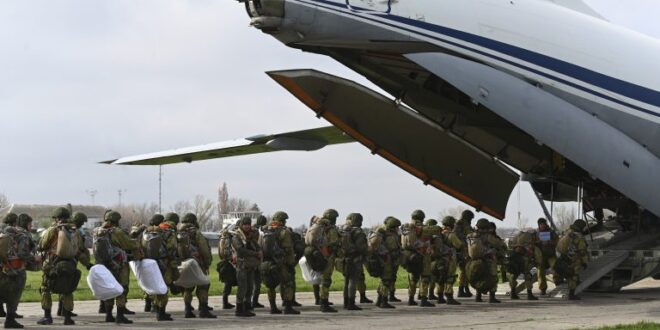While the United States is preoccupied with its rivalry with China, Russia has been asserting itself into the conversation about great power competition, reminding Washington that Moscow itself is a force to be reckoned with.
A Russian military buildup along Ukraine’s eastern border has worried Kiev and Washington—some reports suggest as many as 115,000 Russian troops are now flanking the pro-Russian separatist insurgency.
Continuing contacts between Washington and Moscow are intended to dial back the tensions and perhaps attempt to use June’s summit between Biden and Putin as a stepping stone toward some form of actual progress.
Many see Russia behind recent provocative actions by Belarus, where longtime dictator Aleksandr Lukashenko is turning his country into a pariah state.
While the United States is preoccupied with its ongoing rivalry with China, Russia has been asserting itself into the conversation about great power competition, reminding Washington that Moscow itself is a force to be reckoned with. Buoyed by high energy prices and relishing the disastrous U.S. evacuation efforts in Afghanistan, Russian President Vladimir Putin seeks to convert geopolitical leverage into tangible foreign policy outcomes. Russia continues to solidify its posture in the Arctic region, where its military just tested a hypersonic missile. Moscow also just demonstrated its anti-satellite (ASAT) capability, which led to a large amount of space debris. With nuclear capable torpedoes and a growing investment in artificial intelligence, Russia is aggressively modernizing its military to meet the challenge of great power competition. Historically, when energy prices are high and Putin believes he is in an advantageous position, Russia has acted more brazenly. He could be depending on a politically divided Europe to go soft on sanctions in the event of a possible Russian military action in Ukraine.
A Russian military buildup along Ukraine’s eastern border has worried Kiev and Washington for some time now—reports suggest as many as 115,000 Russian troops are now flanking the pro-Russian separatist insurgency. The Russians have also moved sophisticated weaponry into the region, while also ramping up electronic warfare against Ukrainian surveillance drones. Russian arms also fuel the conflict with more conventional weaponry, with a recent study by Conflict Armament Research detailing the types of weapons flooding in to support the separatists, including rifles, grenade launchers, shoulder-fired antiaircraft missiles, and ammunition. Since Russia’s 2014 annexation of Crimea and occupation of the Donbas region of Ukraine, the conflict has ebbed and flowed; yet, it may be about to intensify once again, given recent movements of troops, equipment, and vehicles. Renewed conflict in Ukraine would pose an immediate challenge to NATO, and Putin is likely betting on a disorganized and patchwork response. Russia continues to weaponize energy reserves, foreshadowing what could be a difficult several months in Western Europe as winter approaches.
In response to growing concerns over an escalation in Ukraine, U.S. Secretary of State Antony Blinken warned Russia: “Any escalatory or aggressive actions [in Ukraine] would be of great concern to the United States.” Nonetheless, Putin has been vocal about what he sees as Russia’s own “red lines”—specifically, the continued buildup of NATO military infrastructure in Ukraine. CIA Director Bill Burns, himself a former diplomat, traveled to Moscow in early November to meet with one of Putin’s top advisers, Nikolai Patrushev. Russia has been angered by U.S. and Ukrainian military cooperation in the Black Sea region, and the continuing contacts between Washington and Moscow are intended to dial back the tensions and perhaps attempt to use June’s summit between U.S. President Joseph Biden and Putin as a stepping stone toward some form of actual progress. At the summit this summer, Biden focused on issues such as cyberattacks, ransomware, and the need to work together on arms control. The New York Times reported on warnings to allies from the U.S. intelligence community of a only limited window to prevent Russia from taking military action in Ukraine, emphasizing the sense of urgency in responding to the growing threat.
Even though the Kremlin has struggled mightily to contain the country’s COVID-19 outbreak, Putin remains popular and was able to put down the nascent protest movement in support of jailed opposition figure Alexei Navalny. Under his leadership, Russia has continued to increase its traditional sphere of influence and has also gravitated more closely toward China. Moreover, many see Russia behind recent provocative actions by Belarus, where longtime dictator Aleksandr Lukashenko is turning his country into a pariah state. In May, Belarus diverted an international flight between Greece and Lithuania in order to apprehend and detain a journalist, Roman Protasevich, who has been critical of Lukashenko. More recently, in response to sanctions, Lukashenko engineered the arrival of between 3,000 and 4,000 migrants from Iraq, Syria, and Afghanistan to his country. Migrants were encouraged to try to cross the border into Poland, in an attempt to destabilize Poland and the European Union more broadly.
 Eurasia Press & News
Eurasia Press & News




